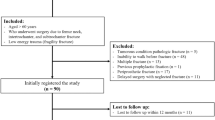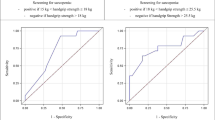Abstract
Background/Objectives
Handgrip strength (HGS) is a potential predictor of outcomes in cancer setting. However, reference values for this population are lacking. The study aimed to describe reference values and cutoff point for HGS in adults with incurable cancer in Brazil and to verify the association of reference values with prognostic.
Methods
Secondary analysis of a prospective cohort, conducted with 1,868 patients at the National Cancer Institute in Brazil were analyzed. HGS (kg) data were obtained with a Jamar® hydraulic dynamometer. Description of percentile values of HGS was stratified by sex and age groups. Receiver operating characteristic curve was performed to determine the optimal HGS cutoff point by sex and age according to performance status. Kaplan–Meier curves was used to analyze the probability of survival and Cox’s proportional model used to identify whether HGS predict 180-d mortality.
Results
HGS value was significantly higher in male than in female and decreased with increasing age. Sex-specific HGS cutoff values ranged from 32.5 to 24.5 kg in males and 20.5 to 18.5 kg in females (with younger adults stronger than the older ones). When compared to HGS ≥50th, patients with HGS ≤10th percentile had significantly lower survival, as well as patients classified below the HGS cutoff point. In addition, patients with lower HGS percentiles showed increased risk of mortality regardless of sex and age.
Conclusion
Reference values can inform the clinical assessment of HGS, which is recognized as an important part of the identification of patients with incurable cancer with reduced physical function and short survival.
This is a preview of subscription content, access via your institution
Access options
Subscribe to this journal
Receive 12 print issues and online access
$259.00 per year
only $21.58 per issue
Buy this article
- Purchase on Springer Link
- Instant access to full article PDF
Prices may be subject to local taxes which are calculated during checkout


Similar content being viewed by others
References
Fearon K, Strasser F, Anker SD, Bosaeus I, Bruera E, Fainsinger RL, et al. Definition and classification of cancer cachexia: an international consensus. Lancet Oncol. 2011;12:489–95.
Kilgour RD, Vigano A, Trutschnigg B, Lucar E, Borod M, Morais JA. Handgrip strength predicts survival and is associated with markers of clinical and functional outcomes in advanced cancer patients. Support Care Cancer. 2013;21:3261–70.
Celis-Morales CA, Welsh P, Lyall DM, Steell L, Petermann F, Anderson J, et al. Associations of grip strength with cardiovascular, respiratory, and cancer outcomes and all-cause mortality: prospective cohort study of half a million UK Biobank participants. BMJ. 2018;361:k1651.
Bohannon RW, Magasi SR, Bubela DJ, Wang YC, Gershon RC. Grip and knee extension muscle strength reflect a common construct among adults. Muscle Nerve. 2012;46:555–8.
Schlüssel MM, dos Anjos LA, de Vasconcellos MT, Kac G. Reference values of handgrip dynamometry of healthy adults: a population-based study. Clin Nutr. 2008;27:601–7.
Alqahtani B, Alenazi A, Alshehri M, Alqahtani M, Elnaggar R. Reference values and associated factors of hand grip strength in elderly Saudi population: a cross-sectional study. BMC Geriatr. 2019;19:271.
Cruz-Jentoft AJ, Bahat G, Bauer J, Boirie Y, Bruyère O, Cederholm T, et al. Sarcopenia: revised European consensus on definition and diagnosis. Age Ageing. 2019;48:16–31.
Contreras-Bolívar V, Sánchez-Torralvo FJ, Ruiz-Vico M, González-Almendros I, Barrios M, Padín S, et al. GLIM criteria using hand grip strength adequately predict six-month mortality in cancer inpatients. Nutrients. 2019;11:2043.
Mendes NP, Barros TA, Faria BS, Aguiar ES, Oliveira CA, Souza ECG, et al. Hand grip strength as predictor of undernutrition in hospitalized patients with cancer and a proposal of cut-off. Clin Nutr ESPEN. 2020;39:210–4.
Norman K, Stobäus N, Smoliner C, Scheufele R, Valentini L, Lochs H, et al. Determinants of hand grip strength, knee extension strength and functional status in cancer patients. Clin Nutr. 2010;29:586–91.
Bohannon RW. Muscle strength: clinical and prognostic value of hand-grip dynamometry. Curr Opin Clin Nutr Metab Care. 2015;18:465–70.
Roberts HC, Denison HJ, Martin HJ, Patel HP, Syddall H, Cooper C, et al. A review of the measurement of grip strength in clinical and epidemiological studies: towards a standardised approach. Age Ageing. 2011;40:423–9.
Wang YC, Bohannon RW, Li X, Sindhu B, Kapellusch J. Hand-grip strength: normative reference values and equations for individuals 18 to 85 years of age residing in the United States. J Orthop Sports Phys Ther. 2018;48:685–93.
Lopes J, Grams ST, da Silva EF, de Medeiros LA, de Brito CMM, Yamaguti WP. Reference equations for handgrip strength: Normative values in young adult and middle-aged subjects. Clin Nutr. 2018;37:914–8.
Budziareck MB, Pureza Duarte RR, Barbosa-Silva MC. Reference values and determinants for handgrip strength in healthy subjects. Clin Nutr. 2008;27:357–62.
Silva GAD, Wiegert EVM, Calixto-Lima L, Oliveira LC. Clinical utility of the modified Glasgow Prognostic Score to classify cachexia in patients with advanced cancer in palliative care. Clin Nutr. 2020;39:1587–92.
de Oliveira LC, Abreu GT, Lima LC, Aredes MA, Wiegert EVM. Quality of life and its relation with nutritional status in patients with incurable cancer in palliative care. Support Care Cancer. 2020;28:4971–8.
Wiegert EVM, de Oliveira LC, Calixto-Lima L, Mota E, Silva Lopes MSD, Peres WAF. Cancer cachexia: comparing diagnostic criteria in patients with incurable cancer. Nutrition. 2020;79-80:110945.
Schag CC, Heinrich RL, Ganz PA. Karnofsky performance status revisited: reliability, validity, and guidelines. J Clin Oncol. 1984;2:187–93.
Chumlea WC, Guo SS, Steinbaugh ML. Prediction of stature from knee height for black and white adults and children with application to mobility-impaired or handicapped persons. J Am Diet Assoc. 1994;94:1385–90.
Frisancho AR. Triceps skin fold and upper arm muscle size norms for assessment of nutrition status. Am J Clin Nutr. 1974;27:1052–8.
Heymsfield SB, McManus C, Smith J, Stevens V, Nixon DW. Anthropometric measurement of muscle mass: revised equations for calculating bone-free arm muscle area. Am J Clin Nutr. 1982;36:680–90.
Mor V, Laliberte L, Morris JN, Wiemann M. The Karnofsky Performance Status Scale. An examination of its reliability and validity in a research setting. Cancer. 1984;53:2002–7.
Leong DP, Teo KK, Rangarajan S, Kutty R, Lanas F, Hui C, et al. Reference ranges of handgrip strength from 125,462 healthy adults in 21 countries: a prospective urban rural epidemiologic (PURE) study. J Cachexia Sarcopenia Muscle. 2016;7:535–46.
Mendes J, Amaral TF, Borges N, Santos A, Padrão P, Moreira P, et al. Handgrip strength values of Portuguese older adults: a population based study. BMC Geriatr. 2017;17:191.
Wong SL. Grip strength reference values for Canadians aged 6 to 79: Canadian Health Measures Survey, 2007 to 2013. Health Rep. 2016;27:3–10.
Steiber N. Strong or weak handgrip? normative reference values for the German population across the life course stratified by sex, age, and body height. PLoS ONE. 2016;11:e0163917.
Ramírez-Vélez R, Correa-Bautista JE, García-Hermoso A, Cano CA, Izquierdo M. Reference values for handgrip strength and their association with intrinsic capacity domains among older adults. J Cachexia Sarcopenia Muscle. 2019;10:278–86.
Dodds RM, Syddall HE, Cooper R, Benzeval M, Deary JI, Dennison EM, et al. Grip strength across the life course: normative data from twelve British studies. PLoS ONE. 2014;9:e113637.
Luna-Heredia E, Martín-Peña G, Ruiz-Galiana J. Handgrip dynamometry in healthy adults. Clin Nutr. 2005;24:250–8.
Guo CB, Zhang W, Ma DQ, Zhang KH, Huang JQ. Hand grip strength: an indicator of nutritional state and the mix of postoperative complications in patients with oral and maxillofacial cancers. Br J Oral Maxillofac Surg. 1996;34:325–7.
Webb AR, Newman LA, Taylor M, Keogh JB. Hand grip dynamometry as a predictor of postoperative complications reappraisal using age standardized grip strengths. JPEN J Parenter Enter Nutr. 1989;13:30–3.
Kerr A, Syddall HE, Cooper C, Turner GF, Briggs RS, Sayer AA. Does admission grip strength predict length of stay in hospitalised older patients? Age Ageing. 2006;35:82–4.
Mendes J, Alves P, Amaral TF. Comparison of nutritional status assessment parameters in predicting length of hospital stay in cancer patients. Clin Nutr. 2014;33:466–70.
Vecchiarino P, Bohannon RW, Ferullo J, Maljanian R. Short-term outcomes and their predictors for patients hospitalized with community-acquired pneumonia. Heart Lung. 2004;33:301–7.
Author information
Authors and Affiliations
Contributions
EVMW, NFS, LCO, and LCL contributed to the conception and design of the research; EVMW, NFS, LCO, and LCL contributed to the acquisition and analysis of the data; EVMW, LCO, and LC, contributed to the interpretation of the data; and EVMW, LCL, and NFS drafted the paper. All authors have critically revised the paper, agree to be fully accountable for ensuring the integrity and accuracy of the work, and have read and approved the final paper.
Corresponding author
Ethics declarations
Conflict of interest
The authors declare no competing interests.
Additional information
Publisher’s note Springer Nature remains neutral with regard to jurisdictional claims in published maps and institutional affiliations.
Rights and permissions
About this article
Cite this article
Wiegert, E.V.M., da Silva, N.F., de Oliveira, L.C. et al. Reference values for handgrip strength and their association with survival in patients with incurable cancer. Eur J Clin Nutr 76, 93–102 (2022). https://doi.org/10.1038/s41430-021-00921-6
Received:
Revised:
Accepted:
Published:
Issue Date:
DOI: https://doi.org/10.1038/s41430-021-00921-6



